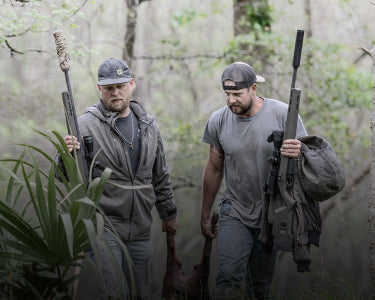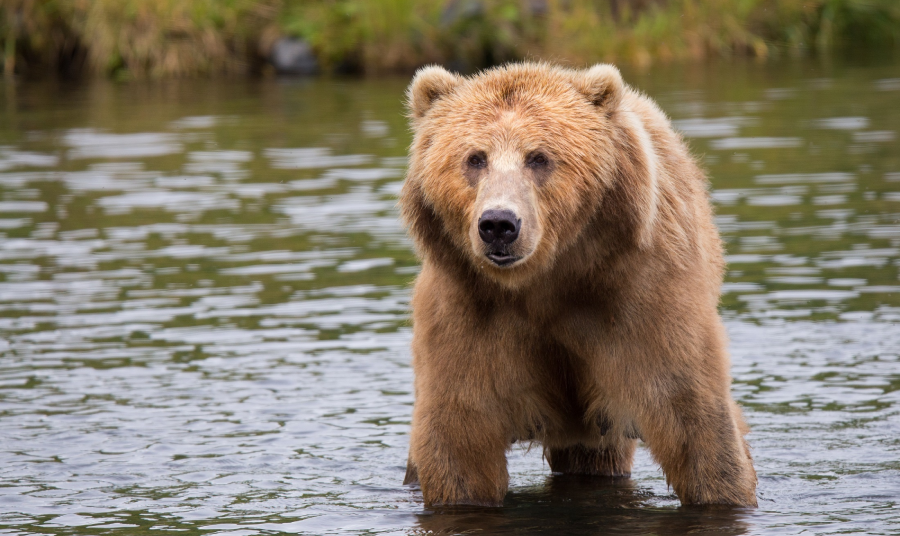Embarking on a pack-in, pack-out DIY bear hunt is an adventure that demands physical stamina, mental fortitude, and a deep understanding of wilderness survival. Whether you are pursuing bears, elks, mule deer, or moose, your choice of gear plays a pivotal role in determining the success of your hunt. Of course, the most important element of a successful hunt is the hunter himself, whose most powerful tools are his will, determination, and wilderness survival skills, but just like our bow-hunting ancestors, a keen mind paired with the best tools can make all the difference in the world.
Why Go Bear Hunting?
Bear hunting is one of the most rewarding and exciting hunts an outdoorsman can embark on. While modern technology has made the sport safer and easier than it was during the time of Davey Crockett, bears are still the most dangerous large mammal in North America. There is a reason for the bear color mnemonic: “If it’s black fight back, if it’s brown lay down, if it’s white good night.”
Disregarding the vicious polar bears, black and brown bears are the two most common species of bear you will encounter. The smaller black bears are scavengers, but can quickly become aggressive if cornered or threatened. Brown bears, on the other hand, are aggressive by nature. If you are caught unaware by a brown bear, out of reach of your weapon, the National Park Service recommends playing dead and remaining still until the bear leaves the area. For black bears, they recommend attacking the creature until it is forced to retreat, just like the mnemonic.
Ecological Benefits of Bear Hunting
Bear hunting serves essential ecological purposes. It helps maintain bear populations at sustainable levels, prevents human-bear conflicts, and reduces competition for huntable animals like deer. By controlling bear populations, we reduce the likelihood of bears encroaching into human habitats, thereby promoting both wildlife conservation and human safety.
Black bear populations have rebounded in about 60% of their historical range, thanks to wildlife management programs funded by revenue received from the issuance of hunting licenses. In some areas, the bear population grows by 5% each year, and bear populations have been on a steady rise since the 1980s. These programs are instrumental in restoring balance to ecosystems and ensuring the long-term survival of these magnificent creatures.
Best Bear Hunting Locations in the U.S.
If you're looking to embark on a black bear hunting adventure, there are several states in the US that offer excellent hunting opportunities during the spring season.
Generally, bears prefer the colder climates of the north. The closer a population of animals gets to the south, the less hibernation the animals need due to the warmer weather, which leads to the bears spending more time hunting and foraging, which may lead to larger animals. North Carolina, for example, is known for its large record-breaking bears, with some bears weighing over 600 pounds thanks to their lack of hibernation and abundance of food, while Alaska is fantastic for the large number of bears that inhabit the state’s frozen frontier regions.
Several other states for great bear hunting include Wisconsin, California, Idaho, Pennsylvania, New Mexico, and New Jersey.
Essential Bear Hunting Camp Gear
Before considering hunting gear, prioritize survival essentials. Waterproof matches, a non-electronic compass, a reliable knife, and nylon paracord in a small survival kit are vital tools for navigating the wilderness and ensuring your safety.
Bears tend to live in areas with cold weather, so it’s important for you to pack warm clothing to ensure you remain comfortable for the long hours of hunting you’ll have to endure. Typical winter hunting clothes are organized in layers. Under-layers are usually made of sweat-wicking material and are meant to regulate the body’s temperature, while mid-layers provide insulation and outer layers provide protection against the elements.
In addition to clothing, other essential gear includes equipment that you would normally bring on an extended camping trip such as a tent, bedding, water (preferably in both a CamelBak and a canteen for ease of access), fire-starting materials, camping food, and lightweight cooking materials. It would also be wise to bring along a rifle backpack capable of carrying both your gear and your firearm, since relying on a sling alone for long treks through the wilderness can be very uncomfortable.
Bear Hunting Gear Checklist
In addition to camping supplies, you should not forget to also bring your hunting necessities such as your gutting kit, paracord, meat bags, headlamp, a GPS navigation system like OnX, and spare batteries.
For bear hunting, you may also want to consider bringing bear spray (for obvious reasons) and some thick drag rope.
Optics for Bear Identification
Binoculars are essential to inspect a bear’s pelt to determine if it’s in good condition and free of any rubbed spots. This is particularly important for late spring and early fall hunts when the pelts are not prime. Since any large animal with dark fur (or a very dark bush for that matter) may be mistaken for a black bear at a great distance, a good pair of binoculars like the Solitude 10x42 will help eliminate any unnecessary stalking.

Scopes for Accurate Shot Placement
Riflescopes like the Presidio 3-18x50 are essential. You will be shooting this animal from 50 to a maximum of 300 yards, and the Presidio’s magnification levels are perfect for those ranges. With its precise clicks and Mil-dot reticle, you can rest assured that your shot will be precise. At shorter ranges like 20 yards or less, a telescopic scope may be a hindrance. Backup iron sights or mini red dots like a Mini Shot M-Spec mounted on a canted rail would be appropriate in case you need to do some impromptu close-range work.
Recommended Calibers for Bear Hunting
As far as rifles are concerned, large caliber rounds such as .30-06 are great for their stopping power, and .45-70 ammo for lever-action rifles are perfectly adequate as well.
How to Get Your Bear Home
After a successful kill and photo, you’ll face the daunting task of hauling a several-hundred-pound animal out of the woods. Unlike deer, bears don’t have any natural handles for you to grab hold of when you drag them off back to camp, and unlike boar, their limbs are too large for you to wrap your hands around. The thick drag rope can be tied around the animal like a harness, but dragging off a bear by yourself is a herculean task. If you bag an especially large bear, it helps to have a team to drag it off.
Bringing the animal back to your truck can be a lot of work. One way is to assemble a five-man team and flip the bear over on its stomach with each man grabbing an elbow or a knee. The legs will not bend back past a certain angle and lock out, and its back will straighten, providing support. If you attempt to drag it out belly up, laying it on its back and picking it up by the legs, it will bend into a U shape and it will be very difficult to get it off the ground.
Preserving Your Bear Meat
It is essential to cool the meat to prevent microbes forming on it. If possible, quarter your bear to speed up the cooling-out process. Doing so is essential for palatable bear meat. If the weather is warm enough for flies, it would be best to cover the meat with a cheesecloth bag or an antimicrobial game bag specifically made for this purpose.
If you're driving back home, avoid placing the bear on the hood of your car. It might look cool, but the engine's heat can spoil the meat. Instead, use a cooler with ice to preserve the meat during transport. Transport the meat in the shade and cover it with a cheesecloth bag or an antimicrobial game bag to keep it clean and protect it from flies.
If flying, consider airlines with baggage options that allow for heavier loads. Carry ice or freezer gel packs to preserve the meat during the flight. You can also choose to mail the meat to yourself using shipping services like UPS or FedEx, which provide guidelines for shipping meat.
Final Thoughts on Bear Hunting Preparation
Bear hunting is a challenging yet rewarding outdoor pursuit that plays a vital role in wildlife management and conservation. To embark on a successful bear hunting expedition, equip yourself with the right gear, prioritize survival skills, and ensure that you handle the meat and fur with care to bring home the rewards of your adventure.
Have a great outdoor adventure story? Share it with us! Accepted stories will receive a 20% discount code.
Frequently Asked Questions
What are some essential gear items needed for a bear hunt?
Some essential gear items for a bear hunt include a quality rifle or bow, appropriate ammunition or arrows, camouflage clothing, scent elimination products, a reliable GPS device, a good pair of binoculars, a sturdy backpack, and a first aid kit.
How important is physical fitness for a bear hunt?
Physical fitness is crucial for a bear hunt as it often involves hiking through rugged terrain, carrying heavy gear, and potentially tracking a wounded animal. Being in good physical shape can increase your chances of success and help you handle the physical demands of the hunt.
What safety precautions should be taken during a bear hunt?
Some safety precautions during a bear hunt include carrying bear spray or a firearm for protection, making noise while hiking to avoid surprising a bear, storing food properly to prevent attracting bears to your campsite, and knowing how to react in case of a bear encounter.
How can hunters contribute to wildlife conservation through bear hunting?
Hunters can contribute to wildlife conservation through bear hunting by helping to maintain bear populations at sustainable levels, preventing human-bear conflicts, and supporting wildlife management programs funded by hunting license revenue. By controlling bear populations, hunters help restore balance to ecosystems and ensure the long-term survival of bear species.
What are some popular bear hunting locations in the US?
Some popular bear hunting locations in the US include states like North Carolina, Alaska, Idaho, Montana, and Pennsylvania. These states offer excellent hunting opportunities for black bears during the spring season, with diverse habitats and abundant bear populations.





